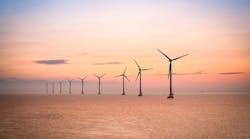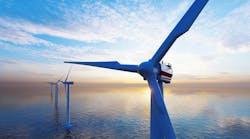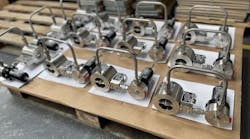Manuel R. Suarez
Kumana & Associates
The result of years of development and lessons learned inFPSOs is that FLNG facilities are finally being built and the first units will soon come onstream. One of them even includes a "re-gasification" step that offers interesting advantages for savings and project flexibility.
The concept of an "all-electric" LNG plant, where all variable speed process drives are electric (i.e., motors, not turbines) has been around for years. Despite advantages in this configuration, few projects have been built (e.g.,Snohvit in Norway). A possible reason is that despite advances in electric drives, early designs and engineering produced when technology was basically limited to turbines continue to be applied under the notion that "existing engineering" is a cost saver. That is usually true but not in this case. Savings opportunities and improved process designs are being missed as a result.
The advantages of "all electric" onshore are even more significant offshore. The advent of FLNG could promote the all-electric design, and could result in a merger of the two concepts into an all-electric FLNG.
Two key characteristics for successful FLNG projects are efficiency and flexibility. The liquefaction technology must be highly efficient in operation, energy use, space, and cost. One reason to choose FLNG is commercial flexibility. Accordingly, the technology selected should be flexible enough to allow processing of a range of feed gas options (e.g., composition, pressure, rates). In turn, LNG train size is a function of the selected technology and the power required for the compressors and drives. A plant configured with multiple trains results in smaller liquefaction modules, an advantage in the space-limited offshore applications. In this context, the following is a comparison of gas turbine versus electric drives:
- Average operational efficiency:
- Gas turbine: (compressor 82%, gas turbine 30%) = 25%
- Electric drive: (generation 55%, transformer 82%, motor 96%, inverter 98%, compressor 82%) = 35%
- Minor maintenance cycle
- Gas Turbine = 4,000 hr
- Electric drive = 25,000 hr (same figures for MTBF)
- Major maintenance cycle
- Gas turbine = 20,000 hr
- Electric drive = 100,000 hr
- Control response
- Gas turbine: slow
- Electric drive: medium to quick
- Efficiency
- Gas Turbine: narrow peak range
- Electric drive: high over a wide range
- Usual delivery time
- Gas Turbine: 3 to 4 years
- Electric drive: 1 to 2 years
- Environmental conditions
- Electric motors are not very sensitive to increases in air temperature. Aeroderivative turbines (commonly used in FLNG applications): about 1.1 % reduction in power available per °C increase in air temperature.
- Turbines need an electric motor for startup (takes the turbine to "firing speed" rpm). These motors contribute to capex but are idle assets for most of the time.
Electric drives are available in a range of power options from 0 to 100 MW. This allows for accurate right-sizing of the motor for a given case and also facilitates the configuration to meet redundancy requirements (e.g., N+1).
For instance, N+1 modules to reduce losses in case of a shutdown of a module. Or, in the power generation segment, for a total power required of 200 MW, a good solution could be a 5 x 25% or 5 x 50 MW arrangement (e.g., four gas turbine + one steam turbine generators).
Also important for this comparison is the concept of "auto-consumption," a measure of the thermal efficiency of a plant as a ratio of the total heating values of fuel gas to feed gas. The goals set by industry for it, as a metric of "return on energy invested," can only be attained using electric motors.
Role of automation
Individual LNG processes are essentially the same on or offshore and their control and automation are reasonably well known and robust. In an all-electric FLNG facility however, with control and automation of generation and demand sides running on a common platform, the challenge is in the integration of the entire facility. This configuration offers opportunities for optimization but it also requires that projects be defined and scoped to avoid counter-productive and possibly even unsafe situations (e.g., overlapping or contradictory strategies, conflicting actions or interlocks, etc.).
Two major areas could be the primary automation targets. First, the heat integration of power generation and process sides: A thermal and electrical power management system to optimize the use of energy beyond "smart grid" concepts and with significant impact on "auto-consumption." For instance, a neural network that can calculate network contingencies, adjust power control, load shedding, re-synchronization, and re-start functions to prevent a full shutdown, etc.
The second automation target is asset management/equipment condition monitoring. In all-electric, the motors are driven by inverters. A system can integrate their data and information with traditional equipment monitoring (e.g., vibration probes, etc.) for advanced monitoring applications. The objective should be to move maintenance from "periodic/preventive" to "predictive" to increase equipment availability, in line with the required operational flexibility of FLNG.
In addition to these two areas, there are many process issues that can be optimized as part of the integration. An example is the liquefaction operating pressure. The energy efficiency of the liquefaction process depends on its operating pressure. High feed-gas pressure requires less power for liquefaction (i.e., lower fuel consumption). However, high operating pressures increase gas treatment costs (removal of acid gas, mercury, heavy hydrocarbons, and dehydration). A neural network could anticipate the optimum operating pressure by balancing these functions.
A "true all-electric" FLNG would include ship propulsion and positioning. Electric propulsion, in use since the 1990s, is currently operating in very large cruise ships, small tankers, and ice-breakers with millions of hours of successful operation. The advantages in maneuverability (e.g., no tugboats required) and fuel economy are enormous. FLNGs usually remain moored at one place, but what about an electrically propelled side-by-side floating storage (SBS FSO) with a regasification unit? Once filled to capacity with LNG, it could move and deliver gas at customers in places that do not have an LNG terminal. The product would be regasified on board the FSO and compressed into a shore side gas pipeline system.
Maybe the second-generation FLNG will be all-electric. This is quite a challenge with huge potential benefits to offset the risks…not to mention a third generation ofvessels under the "true all-electric" concept.




